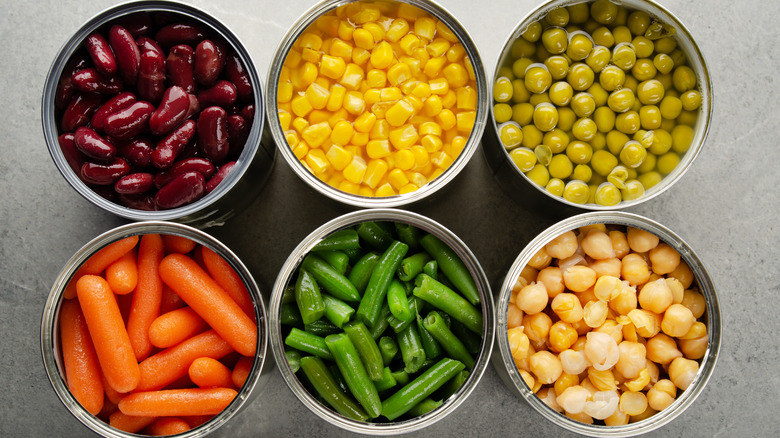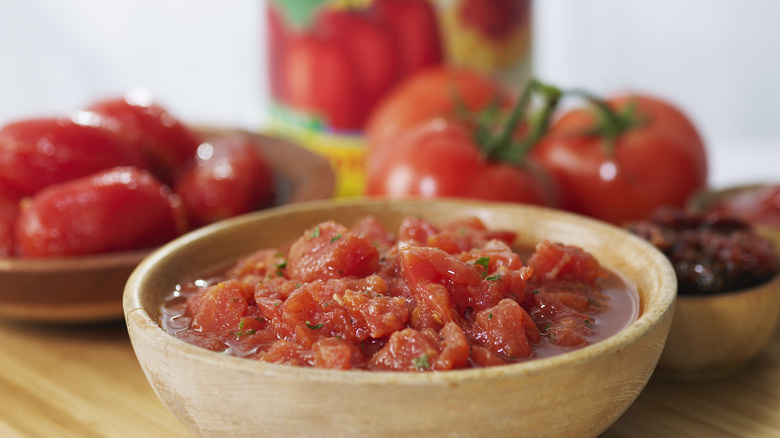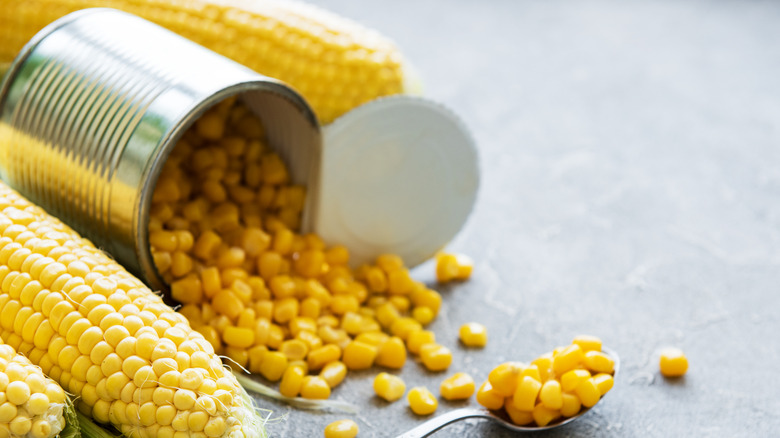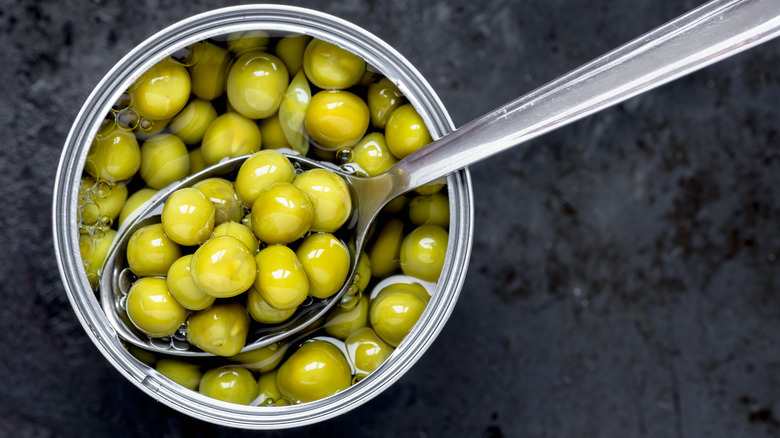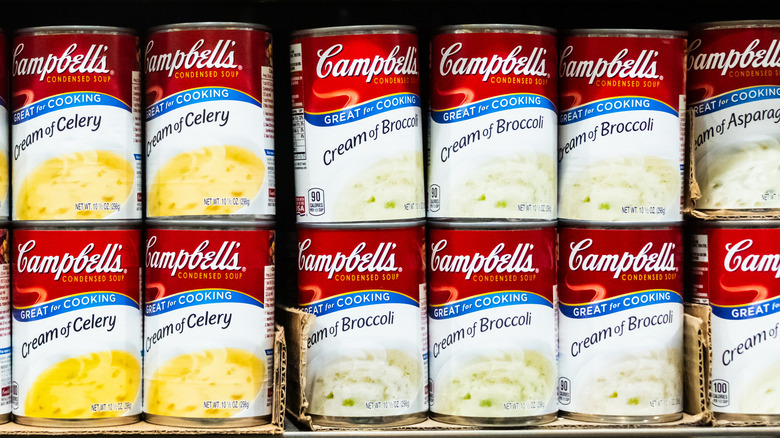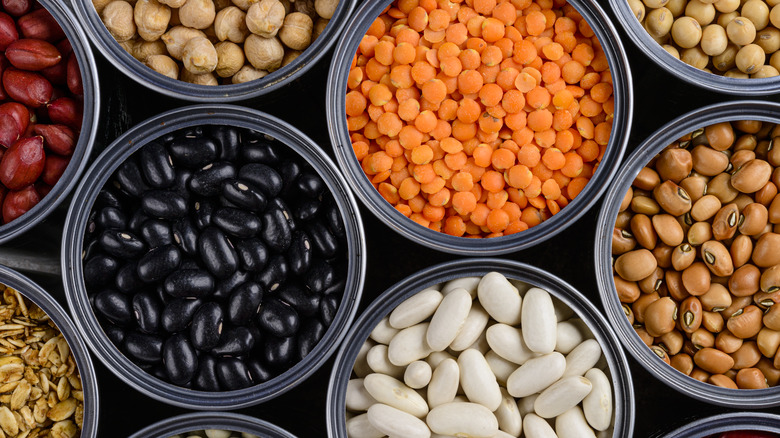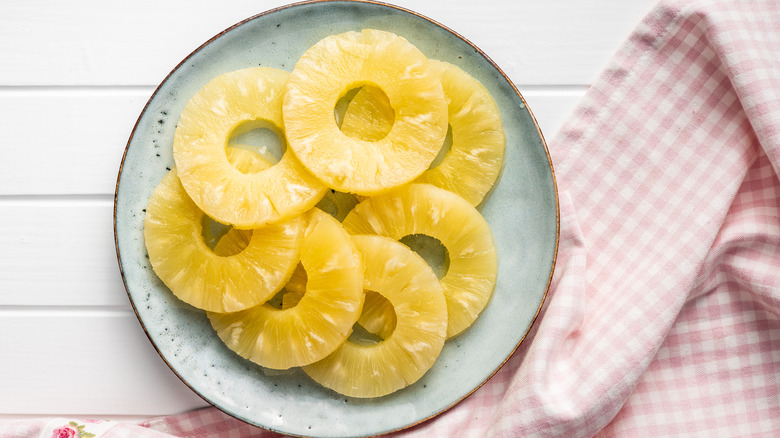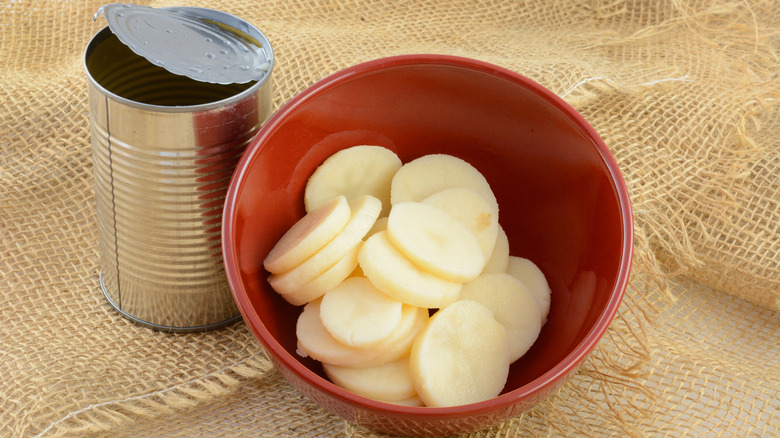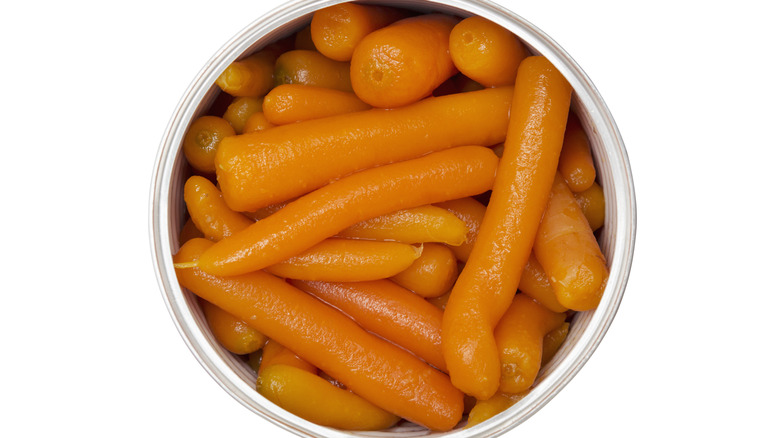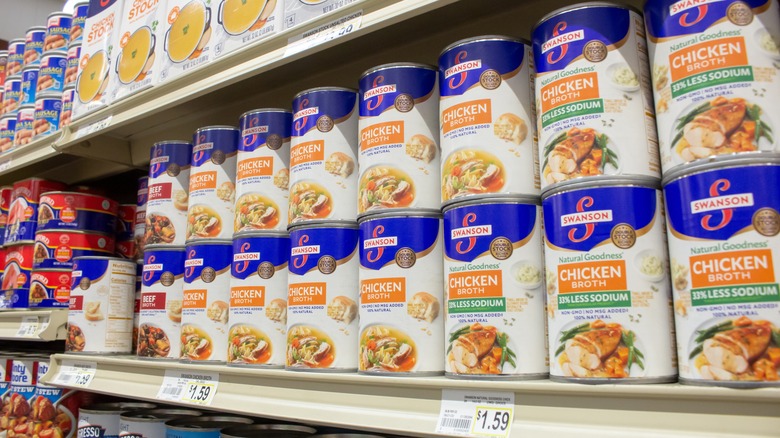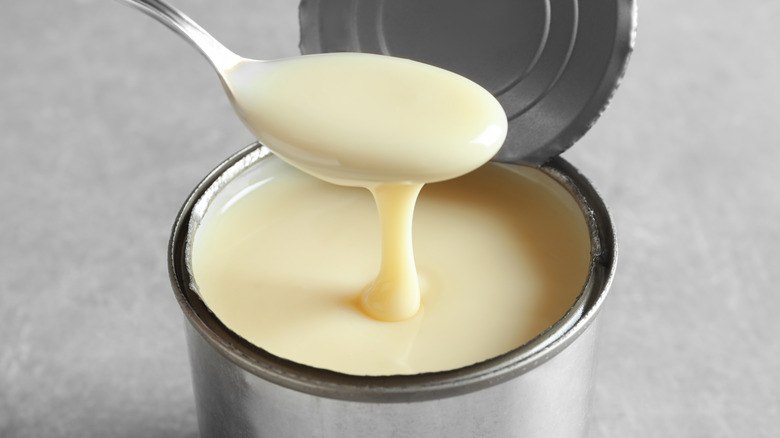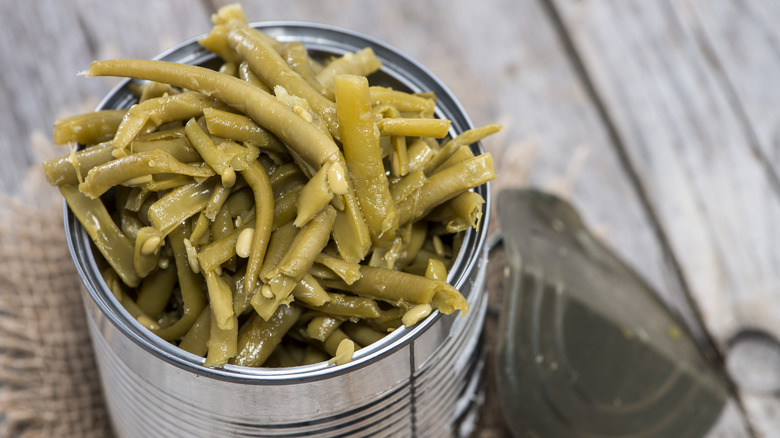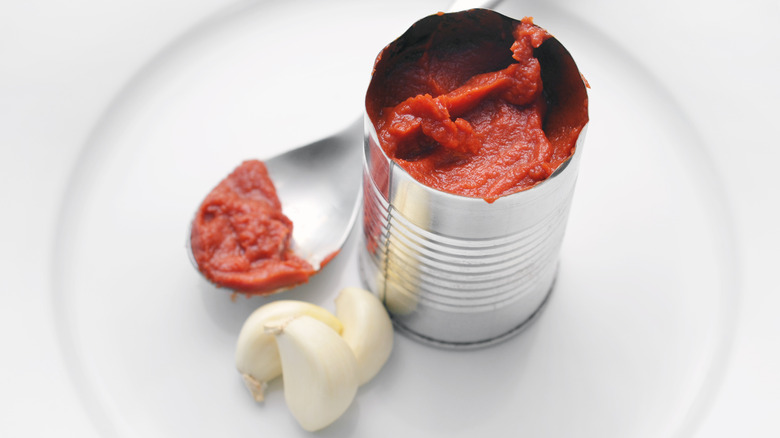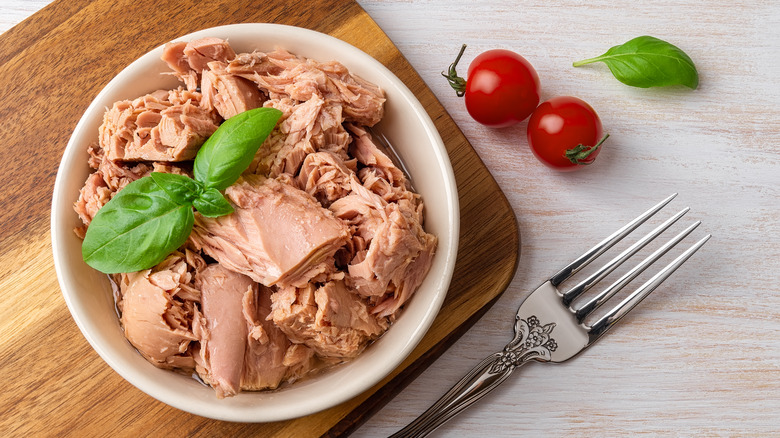13 Inexpensive Canned Foods You'll Use All Of The Time
Canned foods are fantastic for several reasons. First, they have a super long shelf life, so they're great for stocking up. Second, they're inexpensive. Third, they can be used to make a nearly limitless amount of tasty recipes. Whether you like canned foods for their price, convenience, or both, there are a few you should always keep on hand. If you do, you'll find uses for them all of the time. Plus, knowing which inexpensive canned foods to have readily available can save you a lot of time and effort in the kitchen. From making quick sauces to enhancing your baking recipes to bulking up the veggies in your meals, there's an endless number of ways to use canned goods.
Canned foods are no stranger to my kitchen, and there are a few that I keep around and use quite frequently. As a result, compiling a list of 13 inexpensive, super useful canned foods was almost second nature for me. I also perused home cook recommendations and reputable food blogs to ensure I included all the best options, not just the ones that align with my personal preferences. Keep reading to discover what 13 inexpensive canned foods you should always have in the pantry and some of the many ways you can put them to good use.
Tomatoes
Canned tomatoes are one of the most useful food items to keep stocked in your pantry. You can use them in a world of different cuisines, and often, they are much easier to incorporate than raw tomatoes. Not only do they come pre-cooked, but you don't have to deal with the seeds and skins. You can buy canned tomatoes whole (peeled), roasted, diced, puréed, or even mixed with peppers, which further adds to their potential usefulness in the kitchen.
Starting with breakfast, canned tomatoes make the perfect addition to omelets, frittatas, and hashes. Later in the day, they make a great base for various chili recipes, curries, salsas, and so much more. Tomato purée is fantastic in marinades for dishes like pork ribs with garlic and chili peppers and any number of other meat creations. Canned tomatoes also make creating a basic tomato sauce much quicker and easier than starting from scratch with raw tomatoes. Really, the sky's the limit with canned tomatoes.
Of course, canned tomatoes are rather inexpensive, too. Depending on the brand and where you shop, some options are available for less than $1. A large can of imported Italian tomatoes could run you as much as $5, but for the most part, you can get a decent option for between $1 and $3.
Corn
Compared to fresh corn on the cob, canned corn just doesn't compare. However, fresh corn isn't always available. Thankfully, canned corn is ready to step in and help out with a myriad of common recipes when you can't get it fresh (which is more often than you'd think).
Canned corn makes a super simple side dish with just a bit of seasoning. Or you could take it a step further and make a classic bacon succotash. Canned corn is also a welcome addition to just about any type of Southwestern and Latin cuisine. From tacos and burritos to elote and quesadillas and beyond, it mixes right in. Canned corn is also a great option for an array of Cajun foods like red beans and rice and Cajun-style corn chowder. If you like creamed corn (it's not for everyone), a can of it is perfect for enriching sauces and making marinades.
Aside from all of the ways canned corn can be used, it's definitely quicker to pop open a container than shuck a cob, cook it, and remove the kernels. Best of all, canned corn is incredibly inexpensive. It only costs about $0.65 to $1.50 per can.
Peas
Peas are another canned food that comes with a ton of potential. They add a quick splash of color to any meal and, like most canned products, are pre-cooked, so they can be tossed into a dish right at the end or even used as a garnish for salads straight out of the container. Canned peas also make a delicious side dish all by themselves. Or, of course, you can always mix them with other vegetables. In addition, canned peas are excellent in any number of pasta dishes. From elevating boxed macaroni and cheese to making spaghetti with peas and every pasta dish in between, canned peas are ready to help. Pea soup is another classic option, and obviously, you can put peas in just about any meat dish.
A can of peas typically costs between $0.64 and $2, so they are quite inexpensive. Keeping a couple of cans in your pantry at all times is not only affordable, but it's often one of your only options if you want to incorporate them into your meals. Fresh peas aren't always available, so you have to resort to frozen or canned products to fill the gap. Trader Joe's is pretty good at stocking fresh peas, but they go bad within a few days, so they are highly perishable. You won't have that issue with canned peas, though.
Creamed soups
Many creamed soups are delicious straight from the can. However, they really shine when added to other dishes. Canned cream-style soups come in an array of different flavors, like cream of chicken, asparagus, potato, broccoli cheese, mushroom, celery, and much more. When aligned with similar or complementary flavors, they have the power to turn bland, lackluster dishes into next-level creamy delights. For example, they are the perfect addition to savory pies, such as veggie or chicken pot pies. I love using a can of cream of celery soup in my pot pies. Since many pot pies start with celery, carrots, and onions, it accentuates the celery flavor perfectly. It's especially useful when I don't have any celery on hand.
In fact, there are lots of delicious ways to use canned soup, even if they aren't one of the creamed kinds. From enchiladas to scalloped potatoes to inventive eggs and beyond, you may be shocked at how useful they are when you simply keep them around and get a bit creative. A creamy soup is also one of the canned ingredients that upgrade ramen. I know it's just combining two soups, but they add a layer of velvety texture to clear broths that is undeniably tasty. Plus, buying a can of creamed soup for around $1.20 to $2 is much cheaper than buying milk or cream and the herbs and spices needed to create a creamy broth or pie filling from scratch.
Beans
India holds the title for consuming the most beans worldwide, but they are part of most cultural cuisines. As a result, they are an essential element in many diets and are featured in countless recipes. From dips to spreads to soups to hearty fillings and sides, they are the perfect ingredient for bulking up a dish and adding a healthy dose of nutrition. According to the American Heart Association, when you consume beans and rice together, it creates a complete protein. And, with the addition of a veggie (maybe even from a can), you can quickly and easily prepare a well-rounded meal.
One of the best things about canned beans is that it's incredibly simple to add them to dishes. Unlike dried beans, they don't require rehydration. I rinse my canned beans off first, but still, they are much easier to use than dried ones. Additionally, grocery stores sell a myriad of different types of canned beans, further expanding their potential usability. I choose kidney beans and great northern beans for my chili and black beans for my Hispanic dishes. I also love making hummus from chickpeas. Even so, there is plenty of room for variation. Whether you like lentils, pinto beans, navy beans, or something else, they come canned and ready to use.
Fruit
A long list of fruits, including cherries, pears, peaches, pineapple, oranges, and more, can be purchased canned. While they won't have the same fresh, sun-ripened flavor as the fruit you buy from the produce section, they are incredibly handy when it comes to rounding out a variety of dishes. They are also excellent for whipping up a quick fruit salad or as a sweet snack.
Canned fruit is delicious baked into pies or cakes and makes a fantastic ice cream or salad topping. I know this might be a bit controversial, but I love putting canned pineapple on my pizza. I pair it with jalapeños to counterbalance the overt sweetness, and it's amazing. If you're into mixing drinks, canned fruit is also a welcome addition to fruity mocktails and cocktails.
A can of fruit will run you anywhere from $1.50 to $3.50, but all things considered, that is not bad at all. You can leave them on the shelf for a long time without worrying about them perishing, so there's no need to rush and incorporate them into meals. Plus, regardless of the season, you can expect a consistent flavor. Yes, they often come in a sugary syrup, but you can easily drain it off and some brands are much lighter than others.
Potatoes
Potatoes are a staple of diets around the world. Thanks to their subtle taste, they soak up lots of flavors and pair wonderfully with everything. While canned potatoes aren't always at the forefront of people's shopping lists, I think they should be. If you accidentally burn or waterlog fresh potatoes while making a meal, canned potatoes can easily step in and salvage things, with no extra prep or extensive cooking time required. Some canned potatoes even come pre-sliced, making them even easier to work with. Regardless, you can prepare them just like regular potatoes, but with a seriously reduced cook and prep time.
Canned potatoes make tasty roasted potatoes, especially when seasoned with salt, pepper, and garlic. They also make good mashed potatoes. You can even combine canned and instant potatoes to mimic a homemade mash. When blended together, it gives instant potatoes more of the authentic feel that they typically lack. Aside from baked potatoes, you can swap out fresh potatoes for canned ones in just about any recipe that calls for them. In rich stews and hearty, savory pies, you might not even be able to tell the difference.
A single can of potatoes costs approximately $1 to $2, which is fairly inexpensive. Of course, so are fresh potatoes, but the ones in the can are easily stored away for use whenever without any worry of them sprouting or rotting.
Carrots
Unsurprisingly, there's virtually no limit to the ways you can use canned carrots in your cooking. They probably aren't great as a substitute for raw carrots, like in green salads, but other than that, they are pretty much fair game. Canned carrots can be roasted, baked, air-fried, sautéed, or made into purée. They taste great with any meat and enhance pies, stews, soups, and more. I haven't tried it yet, but I bet they'd make a delicious carrot cake, too.
Carrots are also one of the secret ingredients you should be using in your spaghetti sauce. I know I sure do. Don't take my word for it, though: Giada De Laurentiis does, too. The reason carrots make such a wonderful flavor booster for tomato sauce is that they add a touch of sweetness while simultaneously helping balance out the inherent acidity of the tomatoes.
Canned carrots typically cost between $0.75 and $1.70 per can. As some of the cheapest canned foods around, there shouldn't be any question about keeping a can or two handy. Even if you don't necessarily know how you'll use them at the moment, they'll be ready and waiting to help you round out a meal or stand in when you forget to grab the ingredients you want.
Broth
I probably don't have to tell you this, but broth is basically liquid gold in the kitchen, and guess what? Canned broth is just as good as any other kind. It's packed with potent flavor and easily infuses its essence into anything you cook in it. Ask any professional chef, and they'll tell you that they use broth in a number of ways. It can be added to an array of dishes that need liquid, and while water works, broth leads to a much richer, deeper flavor overall. Take basic risotto or orzo (two of my favorite ways to use canned broth), for instance. You could cook them in water, but broth is the superior choice. It infuses each grain with ample flavor from the ground up, and that simply won't be achieved with water, herbs, and spices alone.
Canned broth may not be as large as cartons of broth, but it is perfect for starting an unlimited number of soups. After all, canned broth comes in a wide range of flavors, like chicken, mushroom, beef, pork, and more. Anything from chicken noodle soup to minestrone to ramen to pho requires broth, and a can of the premade stuff gives you a significant head start. You may need a couple of cans, but at only $0.75 to $2 per can, it's definitely worth it for its time-saving potential.
Evaporated milk
If keeping milk around isn't something your household is successful at, either because it gets used super fast or you don't use it all before it expires, evaporated milk can help. If you ever run out of milk or find your carton is spoiled, a can of evaporated milk just might save the day. When mixed with a bit of water, it is an outstanding substitute for milk. While that covers quite a bit of ground, evaporated milk can also be used to make a creamy pasta sauce or dip. Additionally, it's one of the many canned ingredients that take cornbread to the next level.
A can of evaporated milk costs between about $1.20 and $2.20, so not much. The cans aren't always as big as other canned products, but a little bit goes a long way. As an emergency milk substitute, it makes an excellent canned food to have at least on hand at all times.
Sweetened condensed milk is similar to evaporated milk, but as the name suggests, it's sweet. If you are a baker or enjoy making sweet treats, keeping it around could be just as useful as having evaporated milk handy. There are lots of surprising ways to use sweetened condensed milk, like in cakes, pies, or even your coffee and tea.
Green beans
Canned green beans are another one of those veggie options that can be used in a nearly endless amount of recipes. If you have a couple of cans in the pantry, you'll likely find yourself reaching for them all of the time. They can be served as a side dish alongside meat with flavorful seasonings — like these green beans with harissa — or simply with salt and pepper. I like them with lemon-pepper seasoning and garlic.
A can of green beans should only cost you between $0.65 and $1.80. At this price, adding it to your arsenal of canned foods is totally worth it. Canned green beans taste a bit different from their fresh counterparts, but they make a welcome switch in my kitchen when I'm trying to save time. I'm also one of those people who prefers the nostalgic taste of green bean casserole made from canned ingredients on Thanksgiving.
Tomato paste
Similar to whole or diced tomatoes, canned tomato paste and sauce are extremely useful in an array of recipes. Both are the perfect start to a homemade tomato sauce. With Italian herbs and spices and a few additional ingredients (like onions or meat), they allow you to whip up a delicious sauce in a matter of moments. However, I prefer to make a large batch, let it simmer for hours, and freeze a bit so I never run out. Tomato paste is particularly inexpensive ($1-$1.50 per can) when you consider how much you can expand it with water. A single can of paste diluted with two cans of water makes a significant amount of sauce, certainly enough for a meal.
Canned tomato paste and sauce can also be used to make marinades, braises, stews, and soups. It easily enhances a collection of meat dishes, like lamb meatballs, and also instantly infuses flavor into classic comfort foods such as cheesy tomato grits and egg plates.
Tuna
Not everyone likes canned tuna, but if you do, there are lots of ways to use it in your cooking. The most popular use for canned tuna is probably tuna salad. Once made with mayo and not much else, you can eat it as-is, add it to a green salad, put it in a pasta salad, top crackers, or turn it into a much-loved tuna sandwich. It is super easy and fast to make, so it's ideal for whipping up a fast lunch or snack.
Another classic dish you can easily make with canned tuna is a tuna casserole. It's crunchy, creamy, and makes a phenomenal dinner. If convenience and speed are key, you can also upgrade boxed macaroni and cheese with canned tuna. It adds some much-needed protein and a ton of hearty flavor.
Canned tuna is priced starting at $1.15 and goes up to $5 or more for the good stuff. If you spring for the best quality canned tuna, it's not really inexpensive, especially compared to other options on this list. Still, its ability to create a well-rounded meal makes it an excellent canned food to keep in your pantry.

